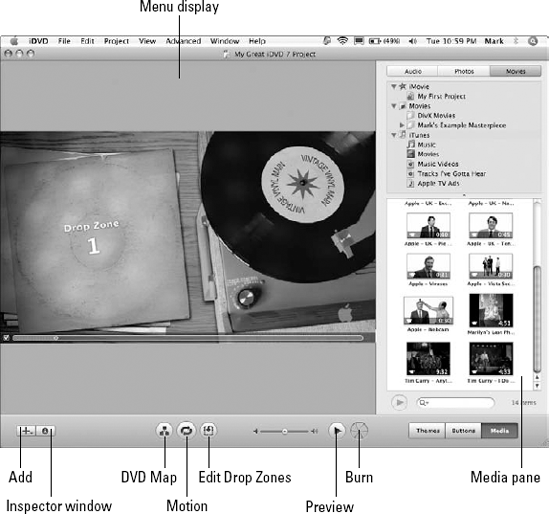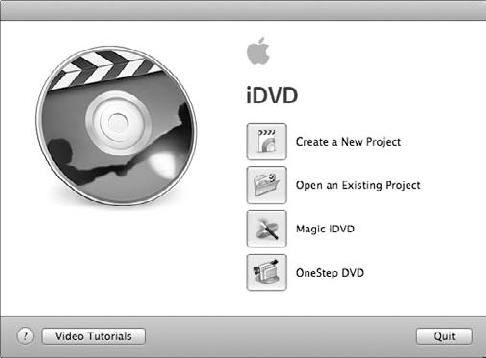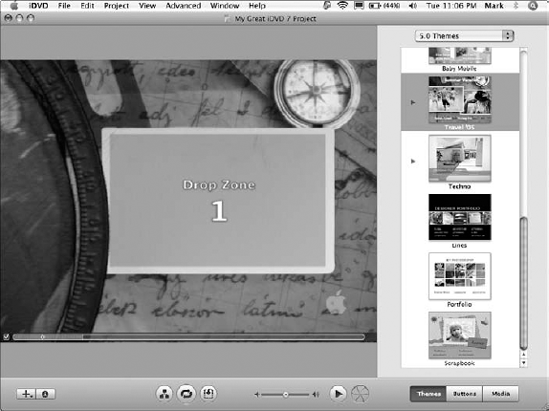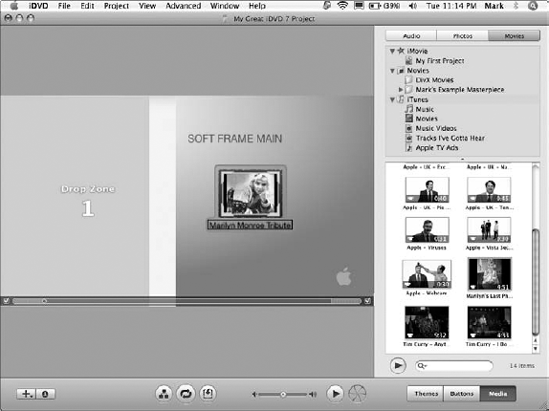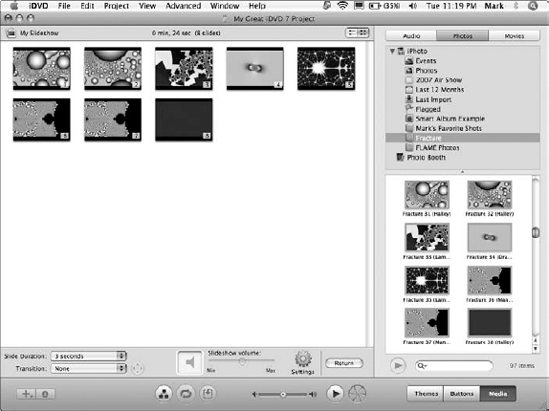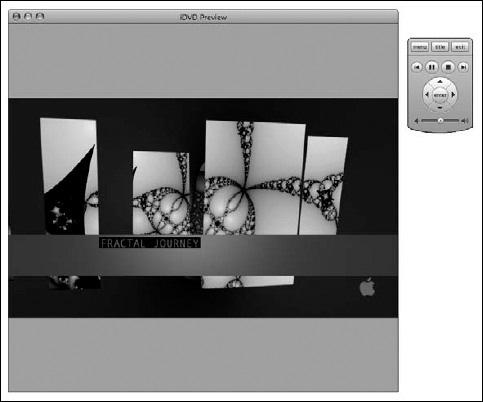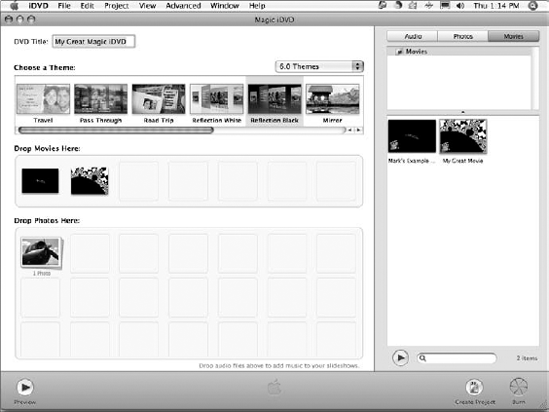In This Chapter
Traversing the iDVD window
Starting a new iDVD project
Tweaking and adjusting your DVD Menu
Previewing your (nearly) finished DVD
Doing things automatically with OneStep DVD and Magic iDVD
Burning a DVD for your friends and family
A number of years ago, I bore witness to yet another proud moment in Apple history: the arrival of a powerful DVD recorder in an affordable computer. The SuperDrive was revolutionary because suddenly folks could create and view their own professional-quality DVDs.
Today the tradition continues: Apple includes iDVD free with today's MacBooks as part of iLife '09. With iDVD, you can easily create beautiful presentations with animation and interactive menus that anyone can watch in a standard DVD player or computer DVD drive. And that, friends and neighbors, is the quintessential definition of cool.
In this chapter, I show you the basics of creating your first home-cooked DVD movie — and you'll even have fun doing it!
Figure 5-1 shows iDVD in all its glory. You have to supply your own digital video clips, background audio, and digital photographs, of course.
Take a moment to appreciate iDVD — no secondary windows to fiddle with or silly palettes strung out everywhere. (Can you tell that I've had my fill of old-style DVD authoring applications?) Allow me to list the highlights of the iDVD window:
Menu display: This section takes up the largest part of the iDVD window, with good reason. You create your project here. In this case, Menu refers to your DVD Menu, not the menu at the top of your MacBook's display.
Media pane: You add video, still images, and audio to your project from here, as well as tweak and fine-tune things. The Media pane actually comprises three separate panes. To choose a new pane, click one of these buttons at the bottom of the screen:
Themes: You apply themes (such as Travel Cards, Wedding White, and Baby Mobile) to your DVD Menu to give it a certain look and feel.
Buttons: These options apply to the item currently selected, such as drop shadows on your text titles or the appearance of your Menu buttons.
Media: From here, you can add media items, such as video clips and photos, to your Menu.
Add button: From this pop-up menu (which sports a dapper plus sign), you can choose one of three types of buttons to add to a project. The choices are
Add Submenu: Choose this item to add a new submenu button to your DVD Menu. The person using your DVD Menu can click a button to display a new submenu that can include additional movies or slideshows. (If that sounds like ancient Greek, hang on. All becomes clearer later in the chapter, in the section "Adding movies.")
Note
A Menu can hold only a maximum of 12 buttons (depending on the theme you choose), so submenus let you pack more content on your DVD. (Older versions of the application allowed only six buttons, so don't feel too cheated.) Anyway, each submenu you create can hold another 12 buttons.
Add Movie: Yep, this is the most popular button in the whole shooting match. Click this menu item to add a new movie clip to your Menu.
Add Slideshow: If you want to add a slideshow to your DVD — say, using photos from your hard drive or pictures from your iPhoto library — click this menu item.
Inspector button: Click this button to display the Inspector window for the current Menu or a highlighted object. From this window, you can change the look of an individual submenu button or an entire Menu.
DVD Map: Click the Map button to display the organizational chart for your DVD Menu. Each button and submenu that you add to your top-level DVD Menu is displayed here, and you can jump directly to a particular item by double-clicking it. Use this road map to help design the layout of your DVD Menu system or to get to a particular item quickly. To return to the Menu display, click the Map button again.
Motion: Click this button to start or stop the animation cycle used with the current iDVD theme. The animation repeats (just as it will on your finished DVD) until you click the Motion button again.
Tip
Need a visual indicator of the length of your Menu's animation cycle? Click View

Edit Drop Zones: This button allows you to edit the look and contents of a drop zone on your Menu. (Don't worry, I explain more about drop zones in the sidebar titled, "Taking advantage of drop zones," later in this chapter.)
Preview: To see how your DVD Menu project looks when burned to a DVD, click Preview. You get a truly nifty on-screen remote control that you can use to navigate your DVD Menu, just as if you were watching your DVD on a standard DVD player. To exit Preview mode, click the Stop button on the remote control.
Burn: Oh, yeah, you know what this one is for — recording your completed DVD movie to a blank disc.
That's the lot! Time to get down to the step-by-step business of making movies.
When you launch iDVD for the first time (or if you close all iDVD windows), you get the sporty dialog shown in Figure 5-2. Take a moment to discover more about these four choices.
If you choose Create a New Project, iDVD prompts you to type a name for your new DVD project and to set a location where the project files should be saved. By default, the very reasonable choice is your Documents folder. You also get to choose whether your project will display in a Standard (full-screen) aspect ratio of 4:3 or a Widescreen aspect ratio of 16:9. If you've been watching DVD movies for some time, you recognize these two terms.
Tip
You'll probably crave Widescreen format if you have a widescreen TV — go figure — but both formats will display on both types of televisions, complete with those black bars we all know and love at the top and bottom (or left and right sides) of the screen.
Click Create, and the iDVD window appears in all its glory.
If you've used iDVD and had a DVD project open the last time you quit the application, iDVD automatically loads the DVD project you were working on. However, you can open any DVD you've created by clicking Open an Existing Project. (To choose a different existing project from the iDVD window, press
If you're a fan of click-it-and-forget-it (or are in a hurry), you can throw caution to the wind and allow iDVD to create your latest epic for you! iDVD offers two automated methods of creating a DVD movie disc.
With OneStep, iDVD does almost all of the work automatically, by using the media clips and photos that you specify. To allow iDVD to help you create a movie, click the OneStep DVD button on the top-level menu (refer back to Figure 5-2). If you've already opened a project, choose File
Magic iDVD is the newcomer on the block, and it falls neatly between total automation (with OneStep DVD) and total manual control. Click the Magic iDVD button on the top-level menu (as shown in Figure 5-2). If you've already opened a project, you can choose File
In contrast to OneStep DVD, you get to preview the finished product. If it's to your liking, you can choose to either burn the disc directly or create a full-blown iDVD project with the results. Sweet.
You find out more about the new Magic iDVD feature later, in the section "A Word about Automation."
Doing things the old-fashioned, creative, and manual way (following the examples in this section) involves four basic steps:
Design the DVD Menu.
Choose a theme and any necessary buttons or links.
Add media.
You can drag movie files from iMovie, still images from iPhoto, and music from iTunes.
Tweak.
Adjust and fine-tune your DVD Menu settings.
Finish things up.
Preview and burn your DVD or save it to your hard drive.
The first step to take when manually designing a new DVD Menu system is to add a theme. In the iDVD world, a theme is a preset package that helps determine the appearance and visual appeal of your DVD Menu, including a background image, Menu animation, an audio track, and a group of settings for text fonts and button styles.
iDVD helps those of us who are graphically challenged by including a wide range of professionally designed themes for all sorts of occasions, ranging from old standbys such as weddings, birthdays, and vacations to more generic themes with the accent on action, friendship, and technology. To view the included themes, click the Themes button in the lower-right corner of the iDVD window (see Figure 5-3).
To choose a theme for your project — or to see what a theme looks like on your Menu — click any thumbnail and watch iDVD update the Menu display.
Tip
If you decide while creating your DVD Menu that you need a different theme, you can change themes at any time. iDVD won't lose a single button or video clip that you add to your DVD Menu. You'll be amazed at how the look and sound of your DVD Menu completely change with just the click of a theme thumbnail.
Drop zones and themes are cool, but most folks want to add video to their DVD. To accomplish this, iDVD uses buttons as links to your video clips. In fact, some iDVD Movie buttons display a preview of the video they'll display! To play the video on a DVD player, you select the Movie button with the remote control, just as you do for a commercial DVD.
To add a Movie button, drag a QuickTime movie file from the Finder and drop it onto your DVD Menu display. (Only MPEG-4 QuickTime movies and DV streams are supported — MPEG-1 and MPEG-2 movie clips may be rejected or converted, or even be added without audio.) Alternatively, click the Add button and choose Add Movie from the pop-up menu.
Tip
iDVD and iMovie are soul mates, so you can also display the iDVD Media pane and then click Movies from the pop-up menu. Now you can drag clips from your Movies folder.
No matter the source of the clip, when you drop it onto your DVD Menu, iDVD adds a Movie button, as you can see in Figure 5-4. Note that some buttons appear as text links rather than actual buttons. The appearance of a Movie button in your DVD Menu is determined by the theme you choose.
Tip
A Movie button doesn't have to stay where iDVD places it! By default, iDVD aligns buttons and text objects using an invisible grid, but if you don't want such order imposed on your creativity, just drag the object to where you'd like it to be to turn on Free Positioning. (You can also right-click the object and select the Free Positioning item from the menu that appears.) iDVD even provides cool new automatic guides that help you align objects when you're using Free Positioning! You'll see them as yellow lines that appear when objects are aligned along a vertical or horizontal plane.
You can have up to 12 buttons on your iDVD Menu (the theme you choose determines the maximum number of buttons you can add). To add more content than 12 buttons allow, add a submenu by clicking the Add button and choosing Add Submenu from the pop-up menu. Now you can click the submenu button to jump to that screen and drag up to another 12 movie files into it.
Note
Keep your target audience in mind while you create your DVD. Standard TV sets have a different aspect ratio (height to width) and resolution (number of scan lines on the screen) than a digital video clip, and a standard TV isn't as precise in focusing that image on the tube. If you selected the Standard aspect ratio when you created the project, you can make sure that your DVD content looks great on a standard TV screen by following these steps:
Click View on the old-fashioned iDVD menu (the one at the top of the screen).
Choose the Show TV Safe Area command.
You can also press the convenient

If you take care that your Menu buttons and (most of) your background image fit within this smaller rectangle, you're assured that folks with a standard television can enjoy your work. To turn off the TV Safe Area rectangle, press
If your entire family is blessed with a fleet of HD TVs (or you chose the Widescreen aspect ratio for this project), leave the Show TV Safe Area option off. Today's widescreen displays can handle just about any orientation.
Many MacBook owners don't realize that iDVD can use not only video clips but also digital photos as content. In fact, you can add a group of images to your DVD Menu by using Slideshow buttons, which allow the viewer to play back a series of digital photographs. iDVD handles everything for you, so there's no tricky timing to figure out or weird scripts to write. Just click the Add button at the bottom of the iDVD window and choose Add Slideshow. iDVD places a Slideshow button on your DVD Menu.
After the Slideshow button is on tap, add the content — in this case, by choosing the images that iDVD adds to your DVD Menu. Follow these steps to select your slideshow images:
Double-click the Slideshow Menu button — the one you just added to the Menu — to open the Slideshow display (see Figure 5-5).
Click the Media button (bottom right of the screen).
Click the Photos tab (top right of the screen) to display your iPhoto library and photo albums.
Drag your favorite image thumbnails from the Photos list and drop them into the My Slideshow window.
Tip
You can also drag images straight from a Finder window or the iPhoto window itself. (Those Apple folks are sooooo predictable.)
Drag around the photos in the My Slideshow window to set their order of appearance in your slideshow.
To add audio to these pictures, drag your favorite audio file from the Finder and drop it in the Audio well in the My Slideshow window.
The Audio well is the box bearing the speaker icon, next to the volume control below the My Slideshow window.
Alternatively, click the Audio tab to select an audio track from your iTunes library, iTunes playlists, or GarageBand creations.
Click the Return button to return to your DVD Menu.
Tip
If you're using a Menu with animated buttons that display an image (rather than text buttons), you can choose which image you want to appear on the Slideshow button. Click the Slideshow button that you added and see the slider that appears above the Slideshow button. Drag this slider to scroll through the images you added. When you find the image that you want to use for the Slideshow button in the DVD Menu, click the Slideshow button again to save your changes.
Most of the Apple-supplied themes already have their own background music, so you might not even need to add music to your DVD Menu. However, if you want to change the existing background music (or if your DVD Menu currently doesn't have any music), adding your own audio to the current Menu is child's play!
Click the Media button.
Click the Audio tab to reveal the musical Shangri-La, as shown in Figure 5-6.
Drag an audio file from the iTunes playlist or GarageBand folder display and drop it on the Menu background.
iDVD accepts every sound format that you can use for importing and encoding in iTunes: AIFF, MP3, AAC, Apple Lossless, and WAV audio files.
Click the Motion button (labeled in Figure 5-1) to watch your DVD Menu animation cycle set to the new background audio.
Click the Motion button again to stop the animation and return to serious work.
You can easily make changes to the default settings provided with the theme you chose. iDVD offers all sorts of controls that allow you to change the appearance and behavior of buttons, text, and the presentation of your content. In this section, I show you how to cast out iDVD's (perfectly good) defaults and then tweak things to perfection.
Hey, Uncle Morty might not be a supermodel, but he has birthdays and anniversaries, and iDVD is more than happy to accommodate you in documenting those milestones! Follow these steps to change the background of your DVD Menu:
Click the Inspector button.
Get an image using one of the following methods:
Drag an image from the Finder and drop it into the Background well.
Drag the image directly into the Menu display.
To use an image from your iPhoto library, click the Media button and click the Photos tab, and then drag the desired image into the Menu display.
iDVD updates the DVD Menu to reflect your new background choice.
The one tweak you'll probably have to perform in every iDVD project is changing titles. Unfortunately, the default labels provided by iDVD are pretty lame, and they appear in two important places:
Menu title: Your large main title usually appears at the top of the DVD Menu.
Button captions: Each Submenu, Movie, and Slideshow button that you add to your Menu has its own title.
To change the text in your Menu title or the titles below your buttons, follow these steps:
Select the text by clicking it.
Click it again to edit it.
A rectangle with a cursor appears to indicate that you can now edit the text.
Type the new text and press Return to save the change.
Customizing Movie buttons? You can do it with aplomb! Follow these steps:
Click Buttons.
Click any Movie button from the DVD Menu to select it.
A slider appears above the button, which you can drag to set the thumbnail picture for that button in your DVD Menu. (Naturally, this is only for animated buttons, not text buttons.)
Tip
Enable the Movie check box to animate the button.
To create a Movie button with a still image, drag a picture from a Finder window or the Media pane and drop it on top of the button.
To adjust the properties for the button, click the Inspector button.
Table 5-1 describes the button properties — note that some properties won't appear for text buttons.
Table 5.1. Button Settings You Can Customize
Movie Button Property | What It Does |
|---|---|
Label Font | Changes the label font, text size, color, and attributes. |
Label Attributes | Specifies the position of the label and whether it has a shadow. |
Custom Thumbnail | Drag an image to the Custom Thumbnail well. For Slideshow buttons, drag the Thumbnail slider to select the image that will appear on the button. |
Transition | Determines the transition that occurs when the button is clicked (before the action occurs). |
Size | Adjusts the size of the button. Move the slider to the right to increase the button size. |
Earlier in this chapter, you find out how to use a different image for your background, but what about using an animated background? You can use any QuickTime movie from your iMovie library (including those you've taken with your MacBook's iSight camera) to animate your DVD Menu background! Didn't I tell you that this iDVD thing was huge?
Tip
Keep in mind that your background movie should be a short clip; 20–30 seconds is optimal. A clip with a fade-in at the beginning and a fade-out at the end is the best choice because iDVD loops your background clip continuously, and your animated background flows seamlessly behind your Menu.
Note
I'm not talking drop zones here. (See the sidebar "Taking advantage of drop zones," earlier in this chapter, for an explanation of drop zones.) You can add a movie to a drop zone, of course, but by using a movie clip as a background, you're replacing the entire animation sequence rather than just a single area of the background. Drop zones also don't provide audio, whereas a clip background does include the clip audio.
Follow these steps to add a new animated background:
Click your old friend, the Inspector button.
Make sure that no individual objects are highlighted so that the Inspector window displays the Menu properties instead.
Drag a movie from the Finder and drop it into the Background well.
You can click the Movies tab in the Media pane to instantly display your iMovie collection.
Click the Motion button in the iDVD window to try out your new background.
Click the Motion button again to stop the animation cycle.
Figure 5-7 captures the elusive Preview remote control — truly an awesome sight. When you click Preview, the Media pane disappears, and your DVD Menu appears exactly as it will on the finished DVD.
Ah, but appearances aren't everything: You can also use your DVD Menu! Click the buttons on the remote control to simulate the remote on your DVD player or think outside the box and click a Menu button directly with your mouse pointer. iDVD presents the video clip, runs the slideshow, or jumps to a submenu, just as it will with the completed disc.
This is a great time to test-drive a project before you burn it to disc. To make sure you don't waste a blank DVD, make certain that everything you expect to happen actually happens. Nothing worse than discovering that Aunt Edna's slideshow from her Hong Kong trip actually displays your family's summer trip to the zoo (whoops). If you made a mistake or something needs tweaking, click the Preview button again, and you're back to the iDVD window proper, where you can edit or fine-tune your project.
Tip
iDVD allows you to save your project as a standard Mac OS X disc image rather than as a simple project file (or a physical DVD) — you can use Apple's Disk Utility to open and mount the disc image as if it were a burned disc. If you move the disc image to another Mac with a SuperDrive, you can use Disk Utility to burn it on that machine. To save an iDVD project as a disc image, choose File
Tip
Interested in tweaking settings across your entire project? Perhaps you'd like to reduce the time it takes to create and edit your DVD or switch video modes from NTSC to PAL for a DVD that's to be sent overseas. If you'd like to view or change the overall settings for your entire DVD, click Project
At the beginning of the chapter, I mention the easy way to produce an iDVD disc or project, using either OneStep DVD (for complete automation) or Magic iDVD (for partial automation). In this section, I provide you with the details.
If you're in a hurry to create a DVD from clips on your DV camcorder and you don't mind losing your creative input, OneStep DVD is just the ticket. In short, iDVD allows you to plug in your FireWire-equipped mini-DV camcorder, answer a question or two, and then sit back while the application does all the work. iDVD imports the DV clips, creates a basic Menu design, and burns the disc automatically! (Again, note that OneStep DVD doesn't support USB camcorders.)
Using OneStep DVD will appeal to any laptop owner with a SuperDrive. Why not produce a DVD right after a wedding or birthday that you can give as a gift? Photographers who cover those same special events might consider selling a DVD made with OneStep DVD. If you happen to capture something incredibly unique — such as a UFO landing or an honest politician — you can use OneStep DVD to create an instant backup of the clips on your DV camcorder. You could even keep your friends and family up-to-date with the progress of your vacation by sending them a daily DVD of your exploits! (You gotta admit, even Grandma would consider that eminently sassy!)
Follow these steps to start the OneStep DVD process:
Click the OneStep DVD button on the iDVD top-level menu (refer to Figure 5-2).
Tip
Alternatively, choose File

iDVD displays the dialog shown in Figure 5-8.
Tip
If you want to use OneStep DVD with an existing movie on your MacBook's hard drive, choose File

Following the prompts, connect the FireWire cable from your DV camcorder; then turn on the camcorder and set it to VCR mode.
Click OK.
Load a blank DVD.
Got a little extra time? For those who prefer to make just a few choices and let iDVD do the rest, the new Magic iDVD feature just plain rocks! However, you can't import clips directly from your mini-DV camcorder as you can with OneStep DVD; instead, you select one of the following:
An iDVD theme
Video clips you've already created with iMovie or dragged from the Finder (perfect for use with a USB 2.0 DV camcorder)
Photos from your iPhoto library or dragged from the Finder
Audio from your iTunes playlist or dragged from the Finder
Follow these steps to start the OneStep DVD process:
Click the Magic iDVD button on the iDVD top-level dialog (refer to Figure 5-2).
iDVD displays the window you see in Figure 5-9.
Click in the DVD Title box and type a name for your disc (or project).
Click to select a theme from the Theme strip.
Click the Movies tab and drag the desired clips into the Drop Movies Here strip.
To add a slideshow, click the Photos tab and drag the desired photos into the Drop Photos Here strip.
To add audio for your slideshow, click the Audio tab and drag the desired song into the Drop Photos Here strip (a speaker icon appears in the first cell of the strip to indicate that you've added a soundtrack).
Click Preview to see a preview of the finished project, complete with remote control. To exit Preview mode, click Exit.
To open the project in its current form in the main iDVD window, click Create Project.
To record your completed project directly to DVD, load a blank DVD and click Burn.
To return to the iDVD main window at any time, just click the Close button on the Magic iDVD window.
When you're ready to record your next Oscar-winning documentary on family behaviors during vacation, just follow these simple words:
Click the Burn button at the bottom of the iDVD window.
I have to admit, the Burn button that appears has to be my favorite single control in all my 20+ years of computing! It looks powerful, it looks sexy ...it wants to burn. (Sorry about that.)
After iDVD asks you to insert a blank DVD-R into the SuperDrive, load a single or dual-layer blank DVD-R, DVD-RW, DVD+R, or DVD+RW (depending on the media your Mac can handle).
Warning
Your SuperDrive might be able to burn and read a DVD+R, DVD-RW, or DVD+RW, but what about your DVD player? Keep in mind that only DVD-Rs are likely to work in older DVD players. The latest generation of DVD players is likely DVD+R compatible as well, but I've seen only a handful of DVD players that can handle rewriteable media at the time of this writing. Therefore, remember the destination for the discs you burn and choose your media accordingly.
After a short pause, iDVD begins burning the DVD. The application keeps you updated with a progress bar.
When the disc is finished, you're ready to load it into your favorite local DVD player or back into your MacBook and enjoy your work using Apple's DVD Player.
Either way, it's all good!

